It was this week back in 1867 that Lucien B. Smith of Kent, Ohio was issued patented #66,182 for “barbed wire”. Smith’s design called for spools of four short, sharp metal spikes at right angles. The spools would revolve loosely and be set every 2 to 3 feet along the fence wire. Soon thereafter, several other patents were issued for slightly different types of “barbed wire”. In fact, there were 570 different patents for different types of wire, twists, and barbs.
When Americans talk about how the frontier was “tamed,” most are talking about the revolver and repeating rifle that helped settlers secure their territory. Some argue, however, that it was the invention of barbed wire that influenced people to settle in the vast, open spaces. With few trees and other fence-building materials, barbed wire is what kept the livestock from wandering off.
Settlers began expanding into the American frontier, which was basically everything west of the Mississippi River, in earnest following the Revolutionary War. It was the Homestead Acts in 1863 that really accelerated settlement of this territory, however, by allowing any who had never taken up arms against the Federal government to put in a claim on 160-acre plots of public land.
New settlers flooding into the Great Plains found it difficult to secure their livestock, however, with few options available on the sparse prairies. The result was loosely defined property lines where cattle and other livestock roamed freely. Few could really afford the astronomical costs of bringing in lumber to fence their farms. Some early homesteaders throughout the Midwest planted Osage orange trees, better known as hedge apples, to keep animals contained, but those took time to mature and didn’t grow reliably in all regions. Many tried building fences from smooth wire but it was ineffective, especially against cattle. The result was western movement across the U.S., but little settlement in the plains.
In the end, it was a farmer from DeKalb, Illinois named Joseph F. Glidden that changed everything. Glidden got his idea for barbed wire when he saw Henry M. Rose’s invention at a county fair: boards with sharp nails hanging from a smooth-wire fence. Glidden thought the board unnecessary and expensive: Why not put the barbs directly in the wire? Glidden’s patent for the modern invention featured a simple wire barb locked onto a double-strand wire. Allegedly, Glidden first convinced his neighbors of the practicability of the invention by making it with his own hands and setting off his farm portions with the fence. As these experiments were gradually improved and exhibited, the demand for the fence grew. He then invented the machinery to mass-produce the wire.
However, his patent application was initially denied on the grounds that his invention was already widely known common knowledge and his process was not novel enough to be distinguished from earlier patents. Glidden promptly appealed and a legal battle ensued, but he was ultimately granted his patent for his design, nicknamed “The Winner,” in 1874. He also successfully fought numerous patent challenges that reached all the way to the Supreme Court.
Glidden entered into a partnership with a young hardware store owner Isaac L. Ellwood and commenced manufacturing as the Barb Fence Company in DeKalb, Illinois. In 1876, Glidden exited the manufacturing aspect, though retaining royalties, by selling his half of the manufacturing business to Washburn and Moen. Sales of Glidden wire by the Washburn & Moen Manufacturing Company rose rapidly from 50 tons in 1874 to 44,000 tons in 1886, and licensees of the patent sold 173,000 tons in 1887. By the time of his death in 1906, Glidden was considered one of America’s richest men. (Sources: GliddenHomestead, ThoughtCo, History Engine)









